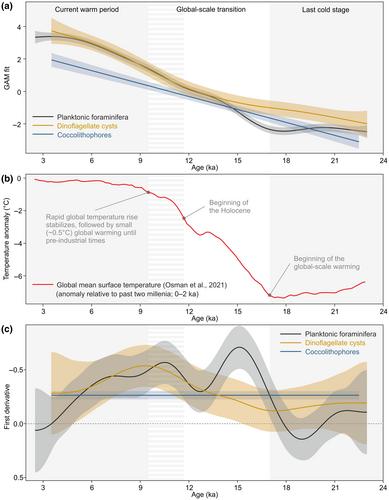Coherent response of zoo- and phytoplankton assemblages to global warming since the Last Glacial Maximum
Abstract
Aim
We are using the fossil record of different marine plankton groups to determine how their biodiversity has changed during past climate warming comparable to projected future warming.
Location
North Atlantic Ocean and adjacent seas. Time series cover a latitudinal range from 75° N to 6° S.
Time period
Past 24,000 years, from the Last Glacial Maximum (LGM) to the current warm period covering the last deglaciation.
Major taxa studied
Planktonic foraminifera, dinoflagellates and coccolithophores.
Methods
We analyse time series of fossil plankton communities using principal component analysis and generalized additive models to estimate the overall trend of temporal compositional change in each plankton group and to identify periods of significant change. We further analyse local biodiversity change by analysing species richness, species gains and losses, and the effective number of species in each sample, and compare alpha diversity to the LGM mean.
Results
All plankton groups show remarkably similar trends in the rates and spatio-temporal dynamics of local biodiversity change and a pronounced non-linearity with climate change in the current warm period. Assemblages of planktonic foraminifera and dinoflagellates started to change significantly with the onset of global warming around 15,500 to 17,000 years ago and continued to change at the same rate during the current warm period until at least 5000 years ago, while coccolithophore assemblages changed at a constant rate throughout the past 24,000 years, seemingly irrespective of the prevailing temperature change.
Main conclusions
Climate change during the transition from the LGM to the current warm period led to a long-lasting reshuffling of zoo- and phytoplankton assemblages, likely associated with the emergence of new ecological interactions and possibly a shift in the dominant drivers of plankton assemblage change from more abiotic-dominated causes during the last deglaciation to more biotic-dominated causes with the onset of the Holocene.


 求助内容:
求助内容: 应助结果提醒方式:
应助结果提醒方式:


